- Home
- »
- Medical Devices
- »
-
Specialty Medical Chairs Market Size And Share Report 2030GVR Report cover
![Specialty Medical Chairs Market Size, Share & Trends Report]()
Specialty Medical Chairs Market Size, Share & Trends Analysis Report By Product (Examination Chairs, Treatment Chairs, Rehabilitation Chairs), By End-use (Hospitals, Clinics, Others), By Region, And Segment Forecasts, 2024 - 2030
- Report ID: GVR-1-68038-657-8
- Number of Report Pages: 110
- Format: PDF, Horizon Databook
- Historical Range: 2018 - 2022
- Forecast Period: 2024 - 2030
- Industry: Healthcare
Specialty Medical Chairs Market Trends
The global specialty medical chairs market size was estimated at USD 4.4 billion in 2023 and is projected to grow at a compound annual growth rate (CAGR) of 7.4% from 2024 to 2030. The demand for specialty medical chairs is anticipated to surge as the elderly population grows. The increasing target population will result in increase in the product demand. The launch of advanced and automated speciality medical chairs is estimated to serve the market with beneficial growth opportunities.
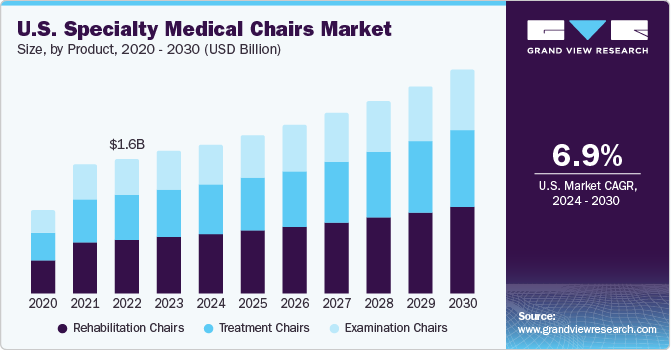
The COVID-19 pandemic initially negatively impacted the demand for the product in 2020. The supply chain was highly disrupted due to the pandemic. The pandemic impacted the overall logistics and shipping of specialty medical chairs products globally, which has resulted in the high cost of container shipment. In 2020, the CARES Act (Coronavirus Aid, Relief, and Economic Security Act) added Section 506J to the Federal Food, Drug, and Cosmetic Act (FD&C Act), which empowered the FDA to prevent or mitigate negative public health impacts of medical device supply chain disruptions during public health emergencies, such as the pandemic. However, the implementation of proactive steps has created better opportunities for the market players owing to the ease in distribution systems due to revised COVID-19 restrictions in different regions post the pandemic.
Key companies are providing customized products to meet the varying needs of patients and clinicians, which is also projected to drive the market growth during the forecast period. On a macro level, supportive reimbursement policies and amending regulatory frameworks are anticipated to fuel the overall market growth. For instance, according to the Medicare Benefit Policy Manual, Chapter 11, a recliner is also covered under the rate that Medicare pays to dialysis clinics.
Market Concentration & Characteristics
Elderly people have low immunity levels and thus, are prone to skeletal, cardiac, and neurological problems, which increases the need for long-term care and recovery. Rising geriatric population is a significant factor propelling the growth of the market.
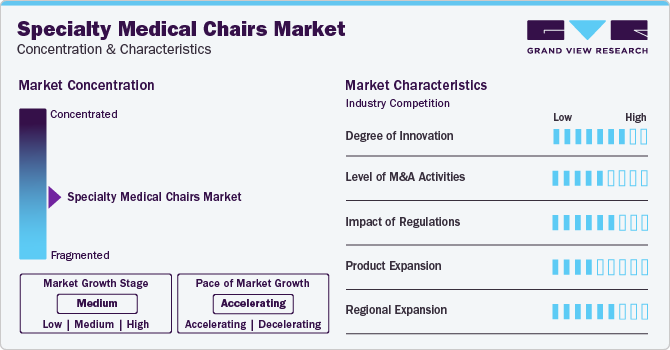
With the increasing global population of elderly people, there is a subsequent increase in the demand for healthcare services and infrastructure to address the unique & evolving healthcare needs of the elderly. According to the WHO data published in 2022, by the year 2030, one out of every six people worldwide will be 60 years or older. The number of individuals in this age group will rise from nearly 1 billion in 2020 to about 1.4 billion by the year 2030. By 2050, the global population of those aged 60 and above is projected to double, reaching 2.1 billion. This, in turn, is estimated to augment the demand for specialty medical chairs over the forecast period.
Government policies such as favourable reimbursement policies, for instance, the Medicare reimbursement program for purchased & rented devices are expected to boost the market for specialty medical chairs. The companies are also adopting numerous strategic initiatives such as a change in distribution footprints to minimize the transit time and freight charges.
Product Insights
The rehabilitation chairs segment held the largest market share of 40.1% in 2023. Pediatric, bariatric, geriatric chairs, and others are subsegments included in rehabilitation chairs segment. Among those used for bathing, positioning, and mobility are pediatric chairs. Similar functions can be performed using the geriatric and bariatric chairs. The rise in geriatric population and surge in cases of spinal injuries and paralysis are expected to drive the segment growth over the forecast period.
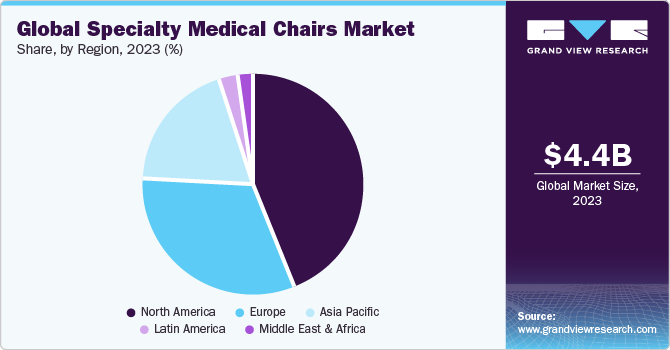
The treatment chairs segment is projected to witness the fastest CAGR of 7.7% over the forecast period. Treatment chairs are a necessary part of any procedure such as surgery. The major advantage correlated with these chairs is that they aid patients accomplish a comfortable posture, which gives doctors unlimited access to numerous parts of a patient’s body. This equipment increases safety for both patients & caregivers and improves patient relaxation. Hence, the increase in advantages of treatment chairs is anticipated to foster market growth.
End-use Insights
The hospitals segment held the largest market share in 2023 due to the high volume of elderly patients. This high volume of elderly patients was attributed to the rise in chronic diseases globally and surged financing and services capabilities of these healthcare settings. In addition, increase in number of patient admissions in hospitals and rise in demand for specialty medical chairs in post-surgical procedures further drives the growth of the market.
Many severe brain injuries or accidents, diseases, congenital disorders, or spinal cord trauma are still treated better in a hospital environment. For spinal cord injuries, a minimum admission of 11 days is required, and the patient is then mostly transitioned to a rehabilitation center. The major goal of a hospital service is to stabilize a person and not provide long-term care. Therefore, a person suffering from temporary or permanent disability needs to obtain a doctor’s prescription to buy a specialty medical chair and avail Medicare benefits.
Regional Insights
North America dominated the market with the largest share of 44.2% in 2023. This large share can be accredited to the increasing geriatric population base and the presence of a supportive reimbursement scenario. The surge in prevalence of lifestyle associated diseases is estimated to drive the regional market during the forecast period. A surge in the number of dental, ophthalmic, and ENT chairs across the U.S. and Canada is also pushing the product demand. In addition, the presence of key market companies, high disposable income levels, and advanced healthcare infrastructure are enabling regional markets to grow.
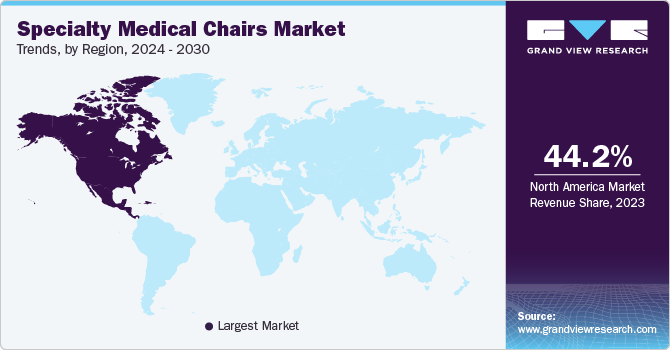
U.S. Specialty Medical Chairs Market Trends
The U.S. held the largest market share in 2023 owing to factors such as presence of large geriatric population and increasing prevalence of cardiovascular diseases (CVDs) in the country. According to a Population Reference Bureau article published in January 2024, the projected growth indicates that the number of Americans aged 65 and older is anticipated to rise from 58 million in 2022 to 82 million by 2050, reflecting a 47% increase. Simultaneously, the share of the total population represented by the 65-and-older age group is expected to rise from 17% to 23%.
Europe Specialty Medical Chairs Market
The Europe specialty medical chairs market was identified as a lucrative region in this industry. The market remained unaffected by the economic downturn in European countries mainly due to the presence of sophisticated healthcare infrastructure, high awareness among patients & practitioners, growing geriatric population, especially, in the Western European region, and introduction of industry-friendly regulations.
UK Specialty Medical Chairs Market Trends
The specialty medical chairs market in UK is expected to grow over the forecast period due to several compelling factors that have fuelled the demand for these medical devices across diverse healthcare settings. The UK has a sizable healthcare system, creating a consistent demand for medical products and a receptive attitude toward innovative technologies.
France Specialty Medical Chairs Market Trends
The specialty medical chairs market in France is expected to grow over the forecast period as the demand for specialty medical chairs is on the rise, driven by several key factors, including the increasing geriatric population and the growing burden of chronic diseases. According to the World Bank, the geriatric population in France has risen from 18% in 2012 to 20.8% in 2020. This demographic shift has contributed to a significant prevalence of chronic diseases in the country.
Germany Specialty Medical Chairs Market Trends
The specialty medical chairs market in Germany is expected to grow over the forecast period owing to the Germany's well-regulated reimbursement scheme playing a crucial role in driving market growth. Approximately 80% of the German population is covered by statutory health insurance policies, and the reimbursement system for medical devices is classified into inpatient and outpatient policies.
Asia Pacific Specialty Medical Chairs Market Trends
Asia Pacific specialty medical chairs market is anticipated to witness significant growth over the forecast period. This growth is attributed to the presence of high growth opportunities that cater to the unmet needs of the target population in this region. Moreover, growing number of surgeries, as well as road accidents in India and other Asian countries, is also driving the market growth. Japan and China have a large elderly population, which is at high risk of chronic conditions. Chronic illness is more common in the geriatric population, and it is expected to boost the demand for specialty medical chairs in the Asia Pacific.
China Specialty Medical Chairs Market Trends
The specialty medical chairs market in China is expected to grow over the forecast period owing to the strong support from government and substantial investments in R&D have played a pivotal role in advancing China's specialty medical chairs market.
Japan Specialty Medical Chairs Market Trends
The specialty medical chairs market in Japan is expected to grow over the forecast period due to favourable government initiatives, including increased awareness of CVDs, promotion of patient safety, and improved reimbursement policies, are contributing to the growth of the market.
Saudi Arabia Specialty Medical Chairs Market Trends
The specialty medical chairs market in Saudi Arabia is expected to grow over the forecast period due to growing geriatric population, which is highly susceptible to chronic diseases such as cancer, diabetes, and neurological diseases.
Kuwait Specialty Medical Chairs Market Trends
The specialty medical chairs market in Kuwait is expected to grow over the forecast period due to the increasing geriatric population, which may offer new opportunities for the market. Moreover, the increasing prevalence of chronic diseases is expected to further boost the application of specialty medical chairs.
Key Specialty Medical Chairs Company Insights
Some of the key players operating in the market include Dentsply Sirona, Danaher, Fresenius Medical Care AG & Co. KGaA, Planmeca Oy.
-
Fresenius Medical Care AG & Co. KGaA is a provider of dialysis care and healthcare services. It offers dialysis treatment and other laboratory services through a network of outpatient dialysis clinics. In addition, it provides renal pharmaceuticals, hemodialysis machines, dialyzers, water treatment systems, and vascular, cardiovascular, & endovascular specialty devices.
-
Danaher is an American science & technology multinational company that designs, manufactures, and markets its products & services to industrial, professional, commercial, & medical customers. The company is a well-diversified medical and industrial conglomerate.
A-dec Inc, Winco Mfg. LLC, and Medcor are some of the emerging participants in the market.
-
A-dec Inc. develops, manufactures, and markets dental equipment & solutions. The company offers dental delivery systems, chairs, lights, stools, electric motors, handpieces, monitor mounts, cabinets, simulators, and other small equipment, along with installation & maintenance services.
-
Winco Mfg. LLC manufactures a range of products from task seating and medical recliners to stretcher chairs that enable and enhance patient and caregiver experience. The company also offers dialysis and blood drawing chairs.
Key Specialty Medical Chairs Companies:
The following are the leading companies in the specialty medical chairs market. These companies collectively hold the largest market share and dictate industry trends. Financials, strategy maps & products of these specialty medical chairs companies are analyzed to map the supply network.
- A-dec, Inc.
- ActiveAid, Inc.
- DentalEZ, Inc.
- Fresenius Medical Care AG & Co. KGaA
- Topcon Corp.
- Midmark Corp.
- Danaher (KaVo Dental GmbH)
- Dentsply Sirona
- Planmeca Oy
- Hill Laboratories Company
Recent Developments
-
In August 2023, Nakanishi Inc. entered into definitive agreement to acquire DCI International, LLC to expand sale of dental chair units and instruments in U.S.
-
In June 2023, A-dec launched A-dec 500 Pro and A-dec 300 Pro delivery systems in North America which are digitally linked dental chair and delivery system.
-
In May 2021, A-dec Inc. and KaVo announced a new collaboration to deliver premier products and world-class services to dental professionals globally.
Specialty Medical Chairs Market Report Scope
Report Attribute
Details
Market size value in 2024
USD 4.6 billion
Revenue forecast in 2030
USD 7.0 billion
Growth rate
CAGR of 7.4% from 2024 to 2030
Actual data
2018 - 2022
Forecast period
2024 - 2030
Quantitative units
Revenue in USD million/billion and CAGR from 2024 to 2030
Report coverage
Revenue forecast, company ranking, competitive landscape, growth factors, and trends
Segments covered
Product, end-use, region
Regional scope
North America; Europe; Asia Pacific; Latin America; MEA
Country scope
U.S.; Canada; Germany; UK; France; Italy; Spain; Denmark; Sweden; Norway; China; Japan; India; South Korea; Australia; Thailand; Brazil; Mexico, Argentina; South Africa; Saudi Arabia, UAE; Kuwait
Key companies profiled
A-dec, Inc.; ActiveAid, Inc.; DentalEZ, Inc.; Fresenius Medical Care AG & Co. KGaA; Topcon Corp.; Midmark Corp.; Danaher (KaVo Dental GmbH); Dentsply Sirona; Planmeca Oy; Hill Laboratories Company
Customization scope
Free report customization (equivalent up to 8 analysts working days) with purchase. Addition or alteration to country, regional & segment scope.
Pricing and purchase options
Avail customized purchase options to meet your exact research needs. Explore purchase options
Global Specialty Medical Chairs Market Report Segmentation
This report forecasts revenue growth at the global, regional, and country levels and provides an analysis of the latest industry trends in each of the sub-segments from 2018 to 2030. For this study, Grand View Research has segmented the global specialty medical chairs market report based on product, end-use, and region:
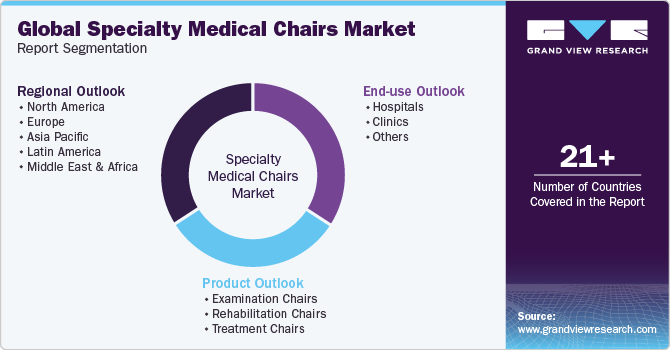
-
Product Outlook (Revenue, USD Million, 2018 - 2030)
-
Examination Chairs
-
Birthing chairs
-
Cardiac chairs
-
Blood drawing chairs
-
Dialysis chairs
-
Mammography chairs
-
-
Rehabilitation Chairs
-
Paediatric chairs
-
Bariatric chairs
-
Geriatric chairs
-
Others
-
-
Treatment Chairs
-
Ophthalmic chairs
-
ENT Chairs
-
Dental chairs
-
Others
-
-
-
End-use Outlook (Revenue, USD Million, 2018 - 2030)
-
Hospitals
-
Clinics
-
Others
-
-
Regional Outlook (Revenue, USD Million, 2018 - 2030)
-
North America
-
U.S.
-
Canada
-
-
Europe
-
UK
-
Germany
-
France
-
Italy
-
Spain
-
Denmark
-
Sweden
-
Norway
-
-
Asia Pacific
-
Japan
-
China
-
India
-
South Korea
-
Australia
-
Thailand
-
-
Latin America
-
Brazil
-
Mexico
-
Argentina
-
-
Middle East & Africa
-
South Africa
-
Saudi Arabia
-
UAE
-
Kuwait
-
-
Frequently Asked Questions About This Report
b. The global specialty medical chairs market size was estimated at USD 4.4 billion in 2023 and is expected to reach USD 4.6 billion in 2024.
b. The global specialty medical chairs market is expected to grow at a compound annual growth rate of 7.4% from 2024 to 2030 to reach USD 7.0 billion by 2030.
b. North America dominated the global specialty medical chairs market with a share of 44.2% in 2023. This is attributable to the rising geriatric population, and well-developed reimbursement structure.
b. Some key players operating in the global specialty medical chairs market include A-dec, Inc.; ACTIVEAID, Inc.; DentalEZ, Inc.; Fresenius Medical Care AG & Co. KGaA; Topcon Corporation; Midmark Corp.; Danaher (KaVo Dental GmbH); Dentsply Sirona; PLANMECA OY; and Hill Laboratories Company.
b. Key factors that are driving the specialty medical chairs market growth include the increasing aging population, a rising number of dental, ophthalmic, and ENT clinics, and advanced healthcare infrastructure.
Share this report with your colleague or friend.
![gvr icn]()
NEED A CUSTOM REPORT?
We can customize every report - free of charge - including purchasing stand-alone sections or country-level reports, as well as offer affordable discounts for start-ups & universities. Contact us now
![Certified Icon]()
We are GDPR and CCPA compliant! Your transaction & personal information is safe and secure. For more details, please read our privacy policy.
We are committed towards customer satisfaction, and quality service.
"The quality of research they have done for us has been excellent."





